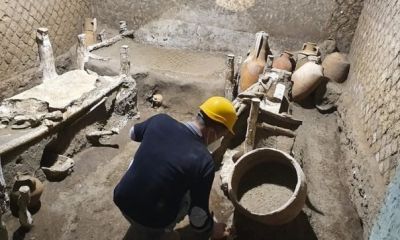Pompeii archaeologists said last month they have unearthed the remains of a "slave room" in an exceptionally rare find at a Roman villa destroyed by Mount Vesuvius' eruption nearly 2,000 years ago. The little room with three beds, a ceramic pot and a wooden chest was discovered during a dig at the Villa of Civita Giuliana, a suburban villa about 1,000 feet from the rest of the ancient city. An almost intact ornate Roman chariot was discovered here at the start of this year, and archaeologists said that the room likely housed slaves charged with maintaining and prepping the chariot. “This is a window into the precarious reality of people who rarely appear in historical sources, written almost exclusively by men belonging to the elite,” said Pompeii’s director general Gabriel Zuchtriegel. The “unique testimony” into how “the weakest in the ancient society lived… is certainly one of the most exciting discoveries in my life as an archaeologist,” he said in a press release. Pompeii was buried in ash when Mount Vesuvius erupted in 79 A.D., killing those who had not managed to leave the city in time. They were either crushed by collapsing buildings or killed by thermal shock. The 170-square-foot room was a cross between a bedroom and a storeroom: along with the beds – one of which was child sized – there were eight amphorae (tall, ancient Roman jars with a handle and narrow neck), stashed in a corner.
Gli archeologici di Pompei hanno dichiarato in ottobre di aver scoperto i resti di una “camera per gli schiavi”, una cosa molto straordinaria. I resti sono stati trovati in una villa romana, chiamata la Villa di Civita Giuliana, che si trova quasi 300 metri dalla città centrale di Pompei. La villa fu distrutta dall'eruzione del Monte Vesuvio quasi 2.000 anni fa. La camera di 16 metri quadrati, aveva tre lettini (uno piccolino come se fosse per un bambino), un vaso di ceramica, un cesto di legna, ed otto anfore (un barattolo grande usato ai tempi, caratterizzato da un manico e un lungo collo). A gennaio, gli archeologi hanno scoperto un carro romano quasi tutto intatto e pensavano che questa camera fosse gli schiavi che mantenevano il carro. Il direttore di Pompei, Gabriel Zuchtriegel, ha detto che queste scoperte sono come una finestra sulla vita degli schiavi durante quest’epoca e non solo ricchi.



